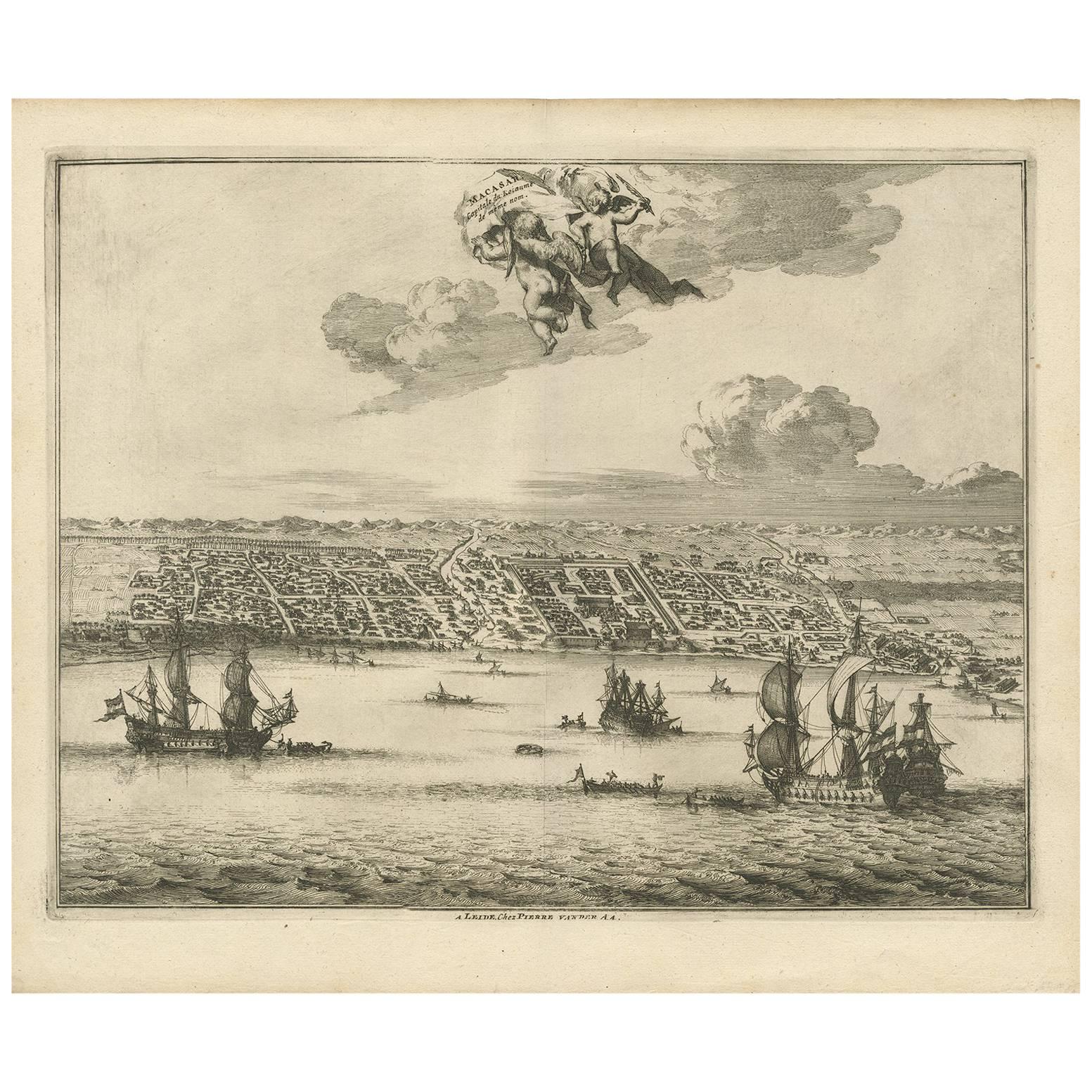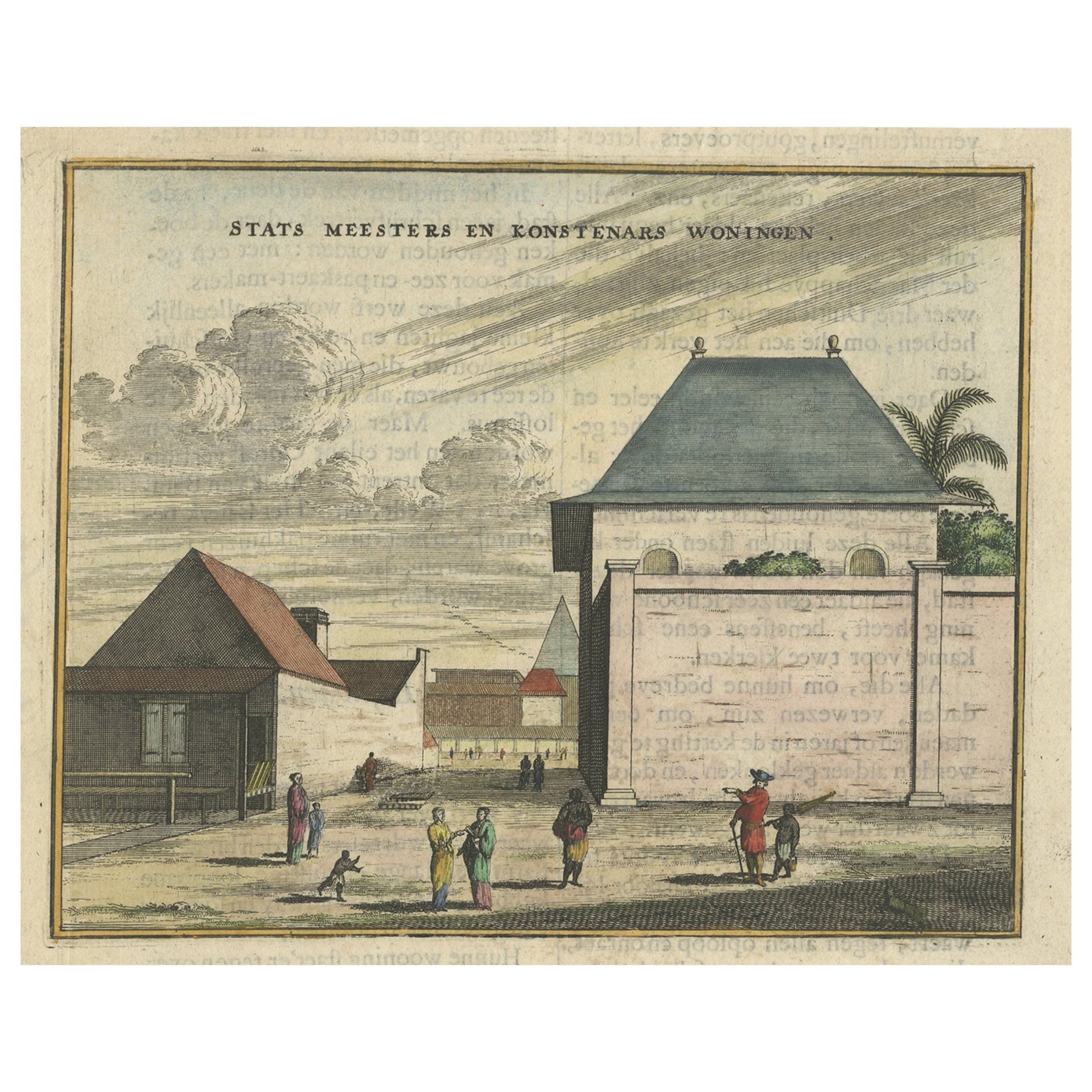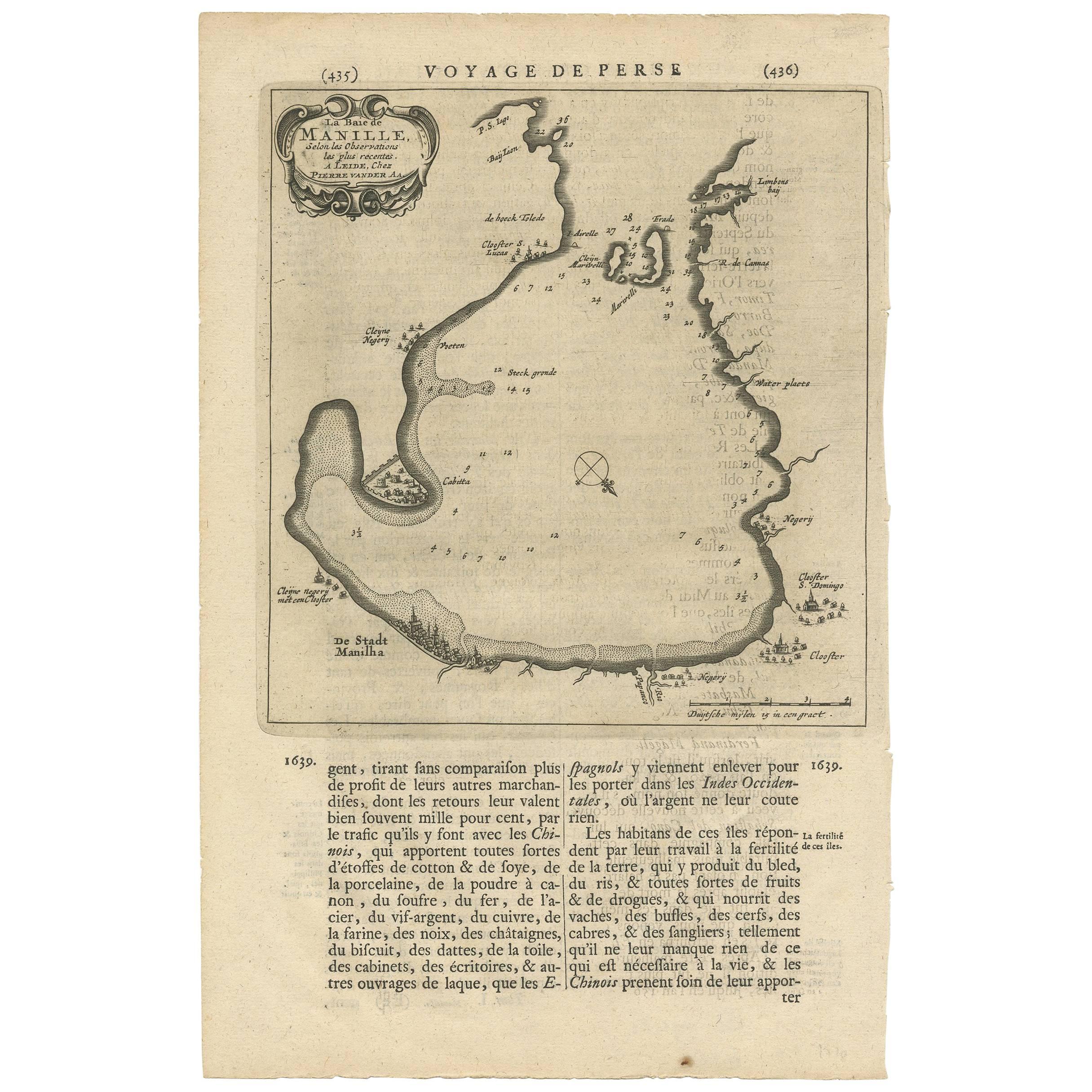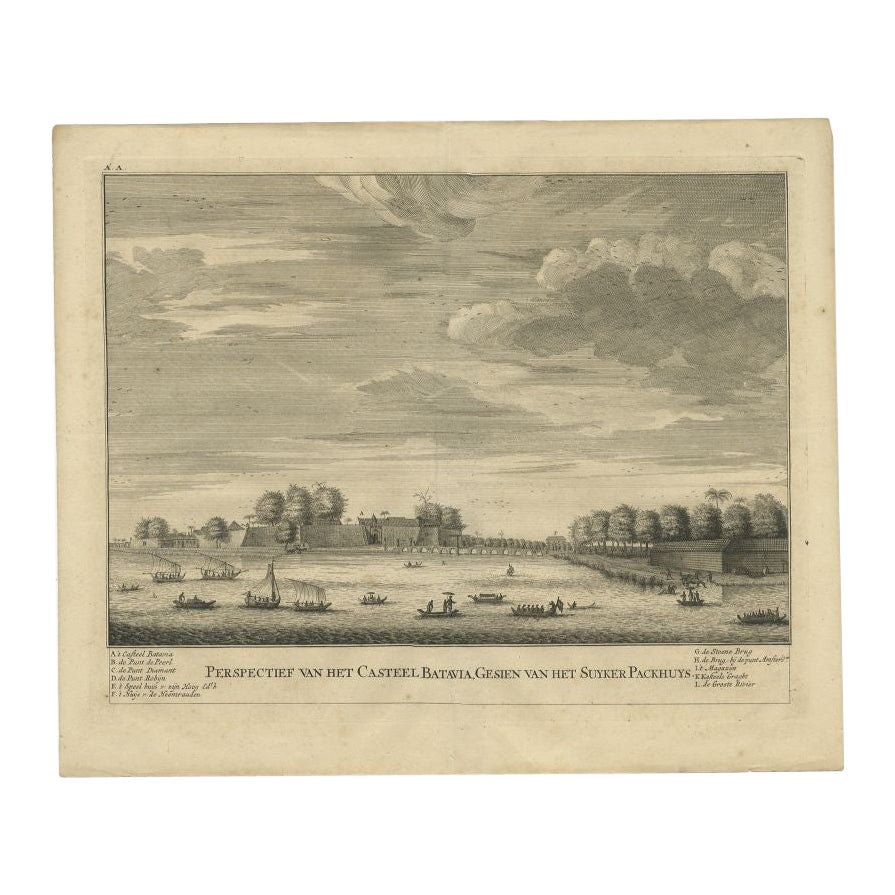Items Similar to Antique Map of Batavia, Jakarta, Indonesia by P. Van Der Aa, 1719
Want more images or videos?
Request additional images or videos from the seller
1 of 5
Antique Map of Batavia, Jakarta, Indonesia by P. Van Der Aa, 1719
About the Item
A small early 18th century black and white map of Batavia by the Dutch cartographer Pieter Van Der Aa. This map was first published in his 'Nouvel Atlas (..)' in 1714 as map 156. The map was re-issued in his monumental work entitled 'Galerie Agreable du Monde'.
- Dimensions:Height: 13 in (33 cm)Width: 7.49 in (19 cm)Depth: 0.02 in (0.5 mm)
- Materials and Techniques:
- Period:
- Date of Manufacture:1719
- Condition:Please study image carefully.
- Seller Location:Langweer, NL
- Reference Number:
About the Seller
5.0
Platinum Seller
These expertly vetted sellers are 1stDibs' most experienced sellers and are rated highest by our customers.
Established in 2009
1stDibs seller since 2017
1,929 sales on 1stDibs
Typical response time: <1 hour
- ShippingRetrieving quote...Ships From: Langweer, Netherlands
- Return PolicyA return for this item may be initiated within 14 days of delivery.
More From This SellerView All
- Antique Print of Makassar 'South Sulawesi, Indonesia' by P. van der AaLocated in Langweer, NLThis rare print shows Makassar, the present capital of South Sulawesi, Indonesia. In the foreground several VOC ships. This print originates from the very scarse: 'La galerie agreabl...Category
Antique Early 18th Century Prints
MaterialsPaper
- Antique Print of Government Houses in Batavia (Jakarta), Indonesia, 1682By Johannes NieuhofLocated in Langweer, NLAntique print titled 'Stats Meesters en Konstenars Woningen'. This print depicts houses of government officials and artists in Batavia, Indonesia. Originates from 'Gedenkweerdige B...Category
Antique 17th Century Prints
MaterialsPaper
- Antique Map of Batavia 'Jakarta, Indonesia' by Montanus, 1679Located in Langweer, NLFine early plan of Batavia (Jakarta), published by Arnoldus Montanus. This map has a vignette at the bottom showing Jakarta from the sea with the volcanoes Mount Gede, Mount Pangrnago and Mount Salak in the background. The plan is based on the earlier, much larger map of Batavia published by Clement de Jonghe...Category
Antique Late 17th Century Unknown Maps
MaterialsPaper
- Antique Map of Manilla Bay Philippines by P. van der Aa, 1719Located in Langweer, NLRare antique map titled 'La Baie de Manille (..)'. Map of Manilla Bay, the map is oriented with southwest at the top and includes a small town plan for Manilla and other places. This...Category
Antique Early 18th Century Maps
MaterialsPaper
- Antique Print of Trade and Merchandise at Bantam, Indonesia by P. Van Der AaBy Pieter Van Der AaLocated in Langweer, NLRare antique print, in this scene: 1. Market in Bantam, Java, Indonesia. 2, Toll house. 3. Chinese Javanese with merchandise. 4. Weight. 5. Spices. 6. Fruit. 7. Domestic objects. 8. Court street...Category
Antique Early 18th Century Prints
MaterialsPaper
- Antique Print of the Castle of Batavia or Nowadays Jakarta, Indonesia, 1726Located in Langweer, NLAntique print titled 'Perspectief van het Casteel Batavia, gesien van het Suyker Packhuys. ' A view of the Castle of Batavia (Jakarta, Indonesia) as seen from the Sugar Warehouse. Th...Category
Antique 18th Century Prints
MaterialsPaper
You May Also Like
- Pair of Bernard De Montfaucon Paris 1719 L'antiquite Original Grand Tour PrintsBy Bernard de MontfaucaonLocated in GBWe are delighted to offer for sale this lovely pair of original copper plate prints dating to 1719 by Bernard De Montfauucon of Paris. Dom Bernard de Montfaucon, O.S.B. (French: [d? m?~fok?~]; 13 January 1655 – 21 December 1741) was a French Benedictine monk of the Congregation of Saint Maur. He was an astute scholar who founded the discipline of palaeography, as well as being an editor of works of the Fathers of the Church. He is regarded as one of the founders of the modern discipline of archaeology Montfaucon was born on 13 January 1655 in the Castle of Soulatgé, a small village in the southern town of Corbières, then in the ancient Province of Languedoc, now in the modern Department of Aude. Other sources claimed his birth date is in 16 January, the most accepted date. After one year he was moved to the Castle of Roquetaillade, residence of his family. When he was seven, he was sent to Limoux, to the college run by the Fathers of Christian Doctrine Montfaucon served in the French army as a volunteer and participated in the Franco-Dutch War of 1673. He was a captain of grenadiers and made two campaigns under the command of Marshall Turenne, participated in the Battle of Herbsthausen and fell ill in Saverne in Alsace. Because of his infectious illness he made a vow to Our Lady of Marceille to give one hundred livres to her sanctuary in Limoux and to become a monk, if he was able to return to his country as a result of her intervention. After the death of Montfaucon's father at the Château de Roquetaillade, in 1675 he entered the novitiate of the Benedictine monastery of Bream in Toulouse. There he learned several ancient languages: Greek, Hebrew, Chaldean, Syriac, and Coptic. In 1687 Montfaucon was called to the Abbey of Saint-Germain-des-Prés and he started to work on an edition of the works of the Greek Church...Category
Antique 1710s French Grand Tour Prints
MaterialsWood, Paper
- Antique Print of St. John the Baptist. After Van Eyck. C.1870Located in St Annes, LancashireWonderful image of John the Baptist after Van Eyck Chromolithograph Printed on card Published C.1870 Unframed.Category
Antique 1870s German Renaissance Prints
MaterialsPaper
- Original Antique Print of An Aristocratic Family After Van Dyck. Dated 1832Located in St Annes, LancashireWonderful image after Van Dyck Fine Steel engraving. Published by Fisher. Dated 1832 Unframed.Category
Antique 1830s English Renaissance Prints
MaterialsPaper
- Map of Indonesia, Semarang, Kartasoera, Soerabaya by SchleyBy Jakob van der SchleyLocated in Norwich, GB'Carte du Chemin entre Samarang et Cartasoera, kaart van den weg tusschen Samarang en Cartasoera' Map of the Road between Semarang and Kartasura by Van Schley. Published 1763. ...Category
Antique 1760s Indonesian Georgian Prints
MaterialsPaper
- 17th Century Pair of Etchings by Theodoor Van Thunlden from Rubens, Antwerp 1642By Theodoor van Thulden, Peter Paul RubensLocated in Cagliari, IT"Arch dedicated to Hercules" and "Arch dedicated to Bellerophon" Splendid and very rare etchings belonging to a suite of subjects executed for the preparations of the "Celebrations for the entry into Antwerp of the Cardinal-Infante Ferdinando of Habsburg-Spain on 17 April 1635". The sketches for the decorations were all drawn by Sir Peter Paul Rubens and the execution of the etchings was entrusted to Van Thulden. Bottom left: P.P. Rubens. Bottom right: G. Gervatius (who was commissioned to bring together the illustrations of the arches in a special volume) and Van Thulden. Laid paper with watermark - copper imprint - margins - excellent condition. At the end of 1634 Peter Paul Rubens (1577-1640) was invited to make a series of drawings to decorate the city of Antwerp on the occasion of the solemn entry of the infant cardinal Ferdinand of Habsburg (1609-1641) who, after his death of Archduchess Isabella Clara Eugenia (1633), Spanish governor of the southern Netherlands, had been elected as his successor. Generally in these circumstances, the itinerary was articulated through a series of stations and the city - in its main urban hubs - was adorned with decorations and ephemeral apparatuses which, without solution of continuity, covered the facades of the palaces, churches and convents facing the parade axis of the celebratory itinerary, testifying to the participatory role of the various public and private institutions that took part in the feast1. As had happened for the entrances of Charles V in 1520, of Philip II in 1549 and of the archdukes Albert and Isabella in 1599, also in this case, on 17 April 1635, the most important streets and squares of Antwerp were enriched with arrangements: temporary altars, four scenarios, a portico and large triumphal arches built in wood, over twenty meters height, decorated with paintings, sculptures and allegorical scenes. The references to the ancient alluded in this case to the greatness of the Habsburgs and to the merits of Ferdinand for the victory obtained over the Protestant armies of Sweden and their German allies. The choice to use the triumphal arch has its roots in the "city of the popes" and must be read as a connection with the triumphal and modern arches, with Rome and with the "possession" ceremony, placing the emphasis on its centuries-old use . In the elaboration of the drawings and sketches Rubens proved to be a true connoisseur of architecture, but what is most surprising about the artist is the casual use of architectural language and fidelity to sixteenth-century Roman models. In order for the memory of these works to be perpetuated over time, some artists were commissioned to etch the ephemeral apparatuses and, under the guidance of the painter Theodor van Thulden...Category
Antique 17th Century Belgian Baroque Prints
MaterialsPaper
- Antique Engraving of a Tucano Mangiapepe by Saverio ManettiLocated in Downingtown, PAAntique engraving of a Tucano Mangiapepe, by Saverio Manetti Circa 1776 A fine hand colored engraving of a Tuscan Magpie by the Italian artist Saverio Manetti. Manetti drew his work predominantly from real specimens. The work was one of the largest ornithology undertakings to that point in time. Dimensions: 25 inches high x 22 inches wide x 1 1/4 inches deep. (frame); (63.5cm high x 55.88cm). 18 x 14 in. (sheet) Reference: Wikipedia Manetti was born in Brozzi to Giovanni Bernardo and Maria Teresa Nesiscolt of Prague. His early studies were in Florence and later at Pisa where he studied botany under Pier Antonio Micheli. He graduated in medicine in 1745 and worked in Florence. In 1758 he joined the National Medical College where he studied anatomy under Antonio Cocchi (1695–1758), conducting the autopsy of Cocchi. Manetti was Professor of Botany of the "Società Botanica Fiorentina", a member of the German Academy of Sciences Leopoldina, a Fellow of the Royal Society, learned societies in Göttingen and Montpellier, an Accademico dell'Istituto di Bologna and he maintained scientific contacts with the Swedish botanist Carl Linnaeus and with the main scientific circles of the second half of the 18th century. He was supervisor of the Orto Botanico di Firenze in Florence from 1749 to 1782 succeeding to Giovanni Targioni Tozzetti and Secretary of the Accademia dei Georgofili. With remarkable organizational effort, he secured the publication of Storia naturale degli uccelli, Natural History of the birds, a monumental work in five volumes illustrated with 600 hand-coloured engravings based on watercolor paintings. The book was commissioned by Maria Luisa, Grand duchess of Tuscany and the first volume was dedicated to Grand Duke Pietro Leopoldo. The third volume was dedicated to Ferdinando di Brobone and the fourth to Giorgio Nassau Clavering. The engravings were made by Tuscan abbot and engraver Lorenzo Lorenzi and Violante Vanni who had studied under British engraver Robert Strange...Category
Antique 1770s Italian Georgian Decorative Art
MaterialsPaper
Recently Viewed
View AllMore Ways To Browse
Map Monde
Atlas Du Monde Antique
Batavia Map
Fine Wood Inlaid Cabinet
Transitional Drawers
Argentina Plata
Vintage Mid Century Signed Desk
Art Deco Cabinet Burl
Wide Cabinet Glass Doors
Five Drawer Commode
Antique English Shelf
Louis Chests Pair
Gold French Louis Cabinets
Set Of Dinnerware
Small Marquetry Cabinet
Ebonized Oak Cabinet
Wall Mounted Decor
French Boulle Cabinet





